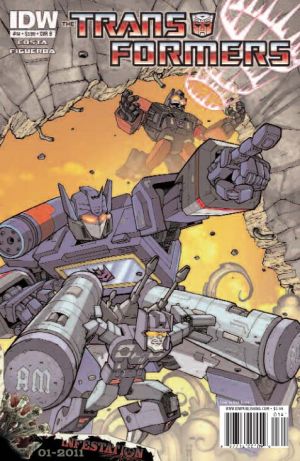Comics /
Comic Reviews /
More Comics
Transformers #14
By Hervé St-Louis
December 30, 2010 - 11:54
Humans are fighting against Transformers with the best weapons possible; duplicate Megatron guns. Can the Autobots overcome this challenge or will they suffer more casualties?
It’s a bit difficult to follow what’s happening with the Transformers’ world sometimes, with so many series. The current series, begun after
All Hail Megatron is good, but there are so many characters spread over so many different places that’s it’s difficult to understand where the series is at. That there are multiple series dedicated to individual characters and that all of this is related is even more confusing. My other criticism is that I always feel shorted when I read a Transformers’ story. It feels like I’m reading a story that lasts about ten pages. The comic book is 22 pages, like most monthly floppies on the market. But there are so many full page spreads and large panels where little happens, that it feels the reader is getting shortchanged. My last criticism related to the story has to do with how it’s not as engaging and character focused as the previous All Hail Megatron. It falls short of expectations. It feels like the highlight of the Transformers’ comic book is seeing an old favourite like Brawn or Bluestreak for a few panels. No story is necessary, no real development or characterization matters.
I’m not a fan of Figuera’s Transformers. He’s never been good with humans either. I don’t like how he makes the Transformers’ faces ugly and alien-like. He also puts way too many details that don’t help strengthen the structure of the images he draws. The inking this issue was inexistent. I grow tired of all these comic book publishers who think they can get away with Photoshop colouring and skip the inking production step. There is some inking here, but it’s not used to solidify the work and make it better. It’s only used to indulge in the artists’ pet peeves. Comic book inking is an art form and a necessary step for pencil-drawn illustrations. Inking cleans the muddiness of a pencil drawing and brings structure and solidity to a drawing. Then, it’s used to establish shadows, highlights and lowlights. It adds dimensions and helps elements in the foreground comes forward and draw the gaze of the reader away from the background and other mid-level layers. Figueroa understands some of these principles, but still falls short in his execution.
Rating: 5 /10
Last Updated: January 17, 2025 - 08:20
